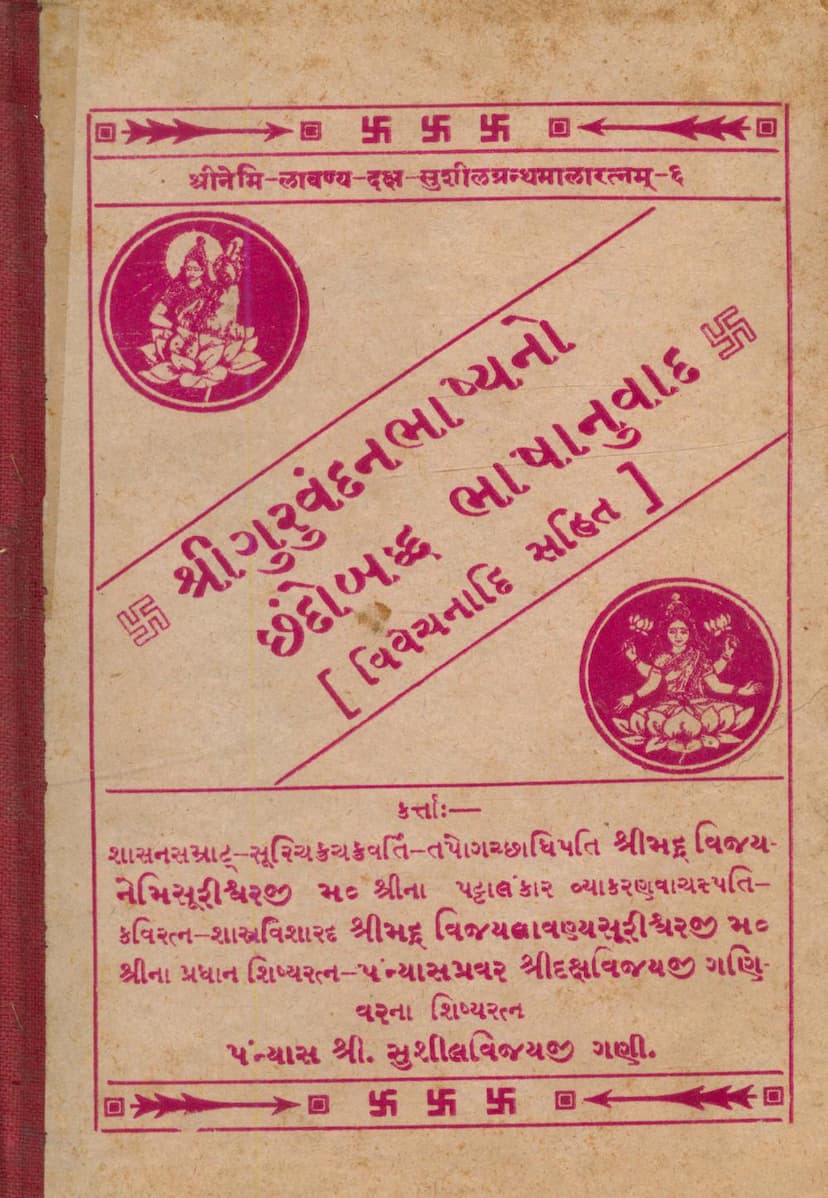Guruvandan Bhashyano Chandobaddh Bhashanuvad
Added to library: September 1, 2025

Summary
Here's a comprehensive summary of the Jain text "Guruvandan Bhashyano Chandobaddh Bhashanuvad" by Sushilvijay, based on the provided text:
Title: Guruvandan Bhashyano Chandobaddh Bhashanuvad (A Metrically Rendered Gujarati Translation of the Guruvandan Bhashya)
Author: Sushilvijay ( disciple of Dakshavijay Gani Varya, who is the principal disciple of Acharya Vijaylavanyasurishwarji Maharaj)
Original Text Author: Acharya Devendrasurishwarji Maharaj (who composed the original Guruvandan Bhashya in Prakrit)
Publisher: Vijaylavanyasuri Gyanmandir
Overall Purpose: This book presents a metrical Gujarati translation, along with commentary and explanations, of the Guruvandan Bhashya, a significant Jain text dealing with the proper etiquette and importance of venerating one's spiritual preceptors (Gurus). The original Bhashya, a concise work, has been rendered into verse to make its teachings more accessible and appealing to the general populace.
Key Themes and Content:
-
Importance of Guru-Vandan: The text strongly emphasizes the paramount importance of a Guru in the Jain path to liberation. The Guru is described as the guiding star for spiritual seekers, essential for acquiring knowledge, detachment, and ultimately, salvation. The introduction highlights that proper veneration of the Guru purifies the spiritual qualities of knowledge, perception, conduct, and austerity.
-
The Guruvandan Bhashya:
- Origin: The original Bhashya was composed by Acharya Devendrasurishwarji in Prakrit, consisting of 41 concise verses (Gathas), making it easy for practitioners to memorize.
- Integration: It is part of the "Bhashya Traya" (three Bhashyas) which are typically studied after Pancapratikraman and four other chapters, indicating its significance in Jain monastic curriculum.
- Translation: Sushilvijay, the translator, found the original Bhashya deeply moving and sought to convey its essence in Gujarati verse. He used the 'Rigit' meter for the main translation and 'Shardulvikridit' for the concluding praise. The translation aims for simplicity and clarity, staying true to the original text without deviating or indulging in excessive imagination.
-
The Significance of Vinay (Humility/Respect): The preface extensively quotes from Umasvati Maharaj's "Prashamarati Prakaran" to explain the virtues of Vinay. It states that Vinay leads to devotion to the Guru, which in turn leads to scriptural knowledge, detachment, control of passions, austerity, purification (nirjara), cessation of actions, inactivity of senses, destruction of the cycle of birth and death, and finally, liberation. Therefore, Vinay is considered the source of all auspiciousness.
-
Types and Methods of Guru-Vandan: The book delves into the various ways of performing Guru-vandan, including:
- Three main types: Feta-vandan, Shobh-vandan (also known as Bhav-vandan or Panchanga-vandan), and Dwadashavarta-vandan.
- Reasons for Twice-Vandan: The text explains the logic behind performing certain venerations twice, using the analogy of a messenger.
- Specific Etiquette: The text details when, whom, and how to perform these venerations, differentiating between various disciples and Gurus based on their status, knowledge, and spiritual lineage.
- Five Names of Vandan: It outlines five ways or classifications of veneration: Vandan-karma, Chitikarma, Kritikarma, Puja-karma, and Vinay-karma, each with distinct principles and examples.
- Illustrative Examples: Numerous stories and examples from Jain scripture and tradition are provided to illustrate the correct and incorrect ways of veneration, emphasizing the importance of inner devotion (Bhav) over mere ritual (Dravya). Examples include the stories of Sheetalacharya, Kshullakacharya, Krishna, Virshalvi, Palak, and Shambakumara.
- Unworthy Gurus (Avandaniya): The text also clarifies who should not be venerated, listing five categories of unworthy individuals (Parshvastha, Avsanna, Kushil, Sansakta, Yathachhanda) and explaining their characteristics.
- Twenty-two Chapters (Dwaras): The book is structured into twenty-two chapters (Dwaras) covering various aspects of Guru-vandan, including the five names of veneration, five illustrative examples, five unworthy categories, five worthy categories, four rules for not having veneration performed by others, four rules for having it performed, five places where veneration is prohibited, four places where it is permitted, eight reasons for veneration, twenty-five essential actions (Avashyakas) for Dwadashavarta-vandan, the significance of observing these actions, twenty-five purifications for the Muhapatti (mouth cloth) and twenty-five for the body, thirty-two faults to be avoided, six virtues gained from veneration, the practice of establishing a Guru in their absence, two types of 'Avagraha' (personal space around the Guru), and the quantitative aspects of the Vandan Sutra (number of letters, words, etc.).
-
Commitment to Dharma and Spiritual Pursuits: The book includes biographical sketches of individuals who financially supported its publication, highlighting their devotion and contributions to Jainism. It also details the extensive religious activities, Chaturmasas (monsoon retreats), preachings, and spiritual observances conducted by the esteemed Acharyas mentioned.
-
Metrical and Philosophical Depth: The translation is praised for its simple language and the presence of 'Prasad' (clarity and flow). It aims to illuminate the original meaning without introducing extraneous concepts or flights of fancy. The inclusion of the original Prakrit verses, Sanskrit translation, and Gujarati prose explanation allows for a deeper understanding of the teachings.
In essence, "Guruvandan Bhashyano Chandobaddh Bhashanuvad" is a scholarly and devotional work that makes the profound teachings on Guru-vandan accessible through beautiful Gujarati poetry, enriching the reader's understanding of the crucial role of a Guru and the proper ways to show reverence in the Jain tradition.